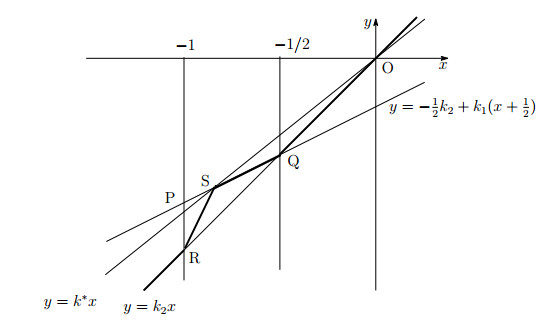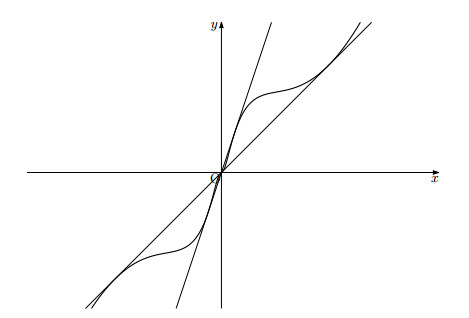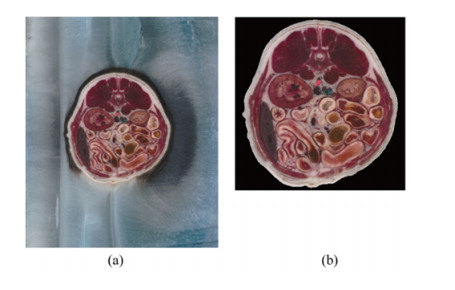1.
Introduction
We consider the system of Hamilton-Jacobi equations
where λ>0 is a given constant, the functions Hi:Rn→R and Bi:R2→R, with i=1,2, are given continuous functions, and Tn denotes the n-dimensional flat torus Rn/Zn.
In a recent paper [6], the authors have investigated the vanishing discount problem for a nonlinear monotone system of Hamilton-Jacobi equations
and established under some hypotheses on the Gi∈C(Tn×Rn×Rm) that, when uλ=(uλ,1,…,uλ,m)∈C(Tn)m denoting the (viscosity) solution of (1.2), the whole family {uλ}λ>0 converges in C(Tn)m to some u0∈C(Tn)m as λ→0+. The constant λ>0 in the above system is the so-called discount factor.
The hypotheses on the system are the convexity, coercivity, and monotonicity of the Gi as well as the solvability of (1.2), with λ=0. Here the convexity of Gi is meant that the functions Rn×Rm∋(p,u)↦Gi(x,p,u) are convex. We refer to [6] for the precise statement of the hypotheses.
Prior to work [6], there have been many contributions to the question about the whole family convergence (in other words, the full convergence) under the vanishing discount, which we refer to [1,3,4,6,8,9,10] and the references therein.
In the case of the scalar equation, B. Ziliotto [11] has recently shown an example of the Hamilton-Jacobi equation having non-convex Hamiltonian in the gradient variable for which the full convergence does not hold. In Ziliotto's approach, the first step is to find a system of two algebraic equations
with two unknowns u,v∈R and with a parameter λ>0 as the discount factor, for which the solutions (uλ,vλ) stay bounded and fail to fully converge as λ→0+. Here, an "algebraic" equation is meant not to be a functional equation. The second step is to interpolate the two values uλ and vλ to get a function of x∈T1 which satisfies a scalar non-convex Hamilton-Jacobi equation in T1.
In the first step above, Ziliotto constructs f,g based on a game-theoretical and computational argument, and the formula for f,g is of the minimax type and not quite explicit. In [5], the author has reexamined the system given by Ziliotto, with a slight generality, as a counterexample for the full convergence in the vanishing discount.
Our purpose in this paper is to present a system (1.3), with an explicit formula for f,g, for which the solution (uλ,vλ) does not fully converge to a single point in R2. A straightforward consequence is that (1.1), with B1(u1,u2)=f(u1−u2) and B2(u1,u2)=g(u2−u1), has a solution given by
under the assumption that Hi(x,0)=0 for all x∈Tn, and therefore, gives an example of a discounted system of Hamilton-Jacobi equations, the solution of which fails to satisfy the full convergence as the discount factor goes to zero.
The paper consists of two sections. This introduction is followed by Section 2, the final section, which is divided into three subsections. The main results are stated in the first subsection of Section 2, the functions f,g, the key elements of (1.3), are contstructed in the second subsection, and the final subsection provides the proof of the main results.
2.
A system of algebraic equations and the main results
Our main focus is now the system
where f,g∈C(R,R) are nondecreasing functions, to be constructed, and λ>0 is a constant, to be sent to zero. Notice that (2.1) above is referred as (1.3) in the previous section.
We remark that, due to the monotonicity assumption on f,g, the mapping (u,v)↦(f(u−v),g(v−u)),R2→R2 is monotone. Recall that, by definition, a mapping (u,v)↦(B1(u,v),B2(u,v)),R2→R2 is monotone if, whenever (u1,v1),(u2,v2)∈R2 satisfy u1−u2≥v1−v2 (resp., v1−v2≥u1−u2), we have B1(u1,v1)≥B1(u2,v2) (resp., B2(u1,v1)≥B2(u2,v2)).
2.1. Main results
Our main results are stated as follows.
Theorem 1. There exist two increasing functions f,g∈C(R,R) having the properties (a)–(c):
(a) For any λ>0 there exists a unique solution (uλ,vλ)∈R2 to (2.1),
(b) the family of the solutions (uλ,vλ) to (2.1), with λ>0, is bounded in R2,
(c) the family {(uλ,vλ)}λ>0 does not converge as λ→0+.
It should be noted that, as mentioned in the introduction, the above theorem has been somewhat implicitly established by Ziliotto [11]. In this note, we are interested in a simple and easy approach to finding functions f,g having the properties (a)–(c) in Theorem 1.
The following is an immediate consequence of the above theorem.
Corollary 2. Let Hi∈C(Rn,R), i=1,2, satisfy H1(0)=H2(0)=0. Let f,g∈C(R,R) be the functions given by Theorem 1, and set B1(u1,u2)=f(u1−u2) and B2(u1,u2)=g(u2−u1) for all (u1,u2)∈R2. For any λ>0, let (uλ,1,uλ,2) be the (viscosity) solution of (1.1). Then, the functions uλ,i are constants, the family of the points (uλ,1,uλ,2) in R2 is bounded, and it does not converge as λ→0+.
Notice that the convexity of Hi in the above corollary is irrelevant, and, for example, one may take Hi(p)=|p|2 for i∈I, which are convex functions.
We remark that a claim similar to Corollary 2 is valid when one replaces Hi(p) by degenerate elliptic operators Fi(x,p,M) as far as Fi(x,0,0)=0, where M is the variable corresponding to the Hessian matrices of unknown functions. (See [2] for an overview on the viscosity solution approach to fully nonlinear degenerate elliptic equations.)
2.2. The functions f,g
If f,g are given and (u,v)∈R2 is a solution of (2.1), then w:=u−v satisfies
Set
which defines a continuous and nondecreasing function on R.
To build a triple of functions f,g,h, we need to find two of them in view of the relation (2.3). We begin by defining function h.
For this, we discuss a simple geometry on xy-plane as depicted in Figure 1 below. Fix 0<k1<k2. The line y=−12k2+k1(x+12) has slope k1 and crosses the lines x=−1 and y=k2x at P:=(−1,−12(k1+k2)) and Q:=(−12,−12k2), respectively, while the line y=k2x meets the lines x=−1 and x=−12 at R:=(−1,−k2) and Q=(−12,−12k2), respectively.
Choose k∗>0 so that 12(k1+k2)<k∗<k2. The line y=k∗x crosses the line y=−12k2+k1(x+12) at a point S:=(x∗,y∗) in the open line segment between the points P=(−12,−12(k1+k2)) and Q=(−12,−12k2). The line connecting R=(−1,−k2) and S=(x∗,y∗) can be represented by y=−k2+k+(x+1), with k+:=y∗+k2x∗+1>k2.
We set
It is clear that ψ∈C(R) and increasing on R. The building blocks of the graph y=ψ(x) are three lines whose slopes are k1<k2<k+. Hence, if x1>x2, then ψ(x1)−ψ(x2)≥k1(x1−x2), that is, the function x↦ψ(x)−k1x is nondecreasing on R.
Next, we set for j∈N,
It is clear that for all j∈N, ψj∈C(R), the function x↦ψj(x)−k1x is nondecreasing on R, and
We set
It is clear that η∈C(R) and x↦η(x)−k1x is nondecreasing on R. Moreover, we see that
and that if −2−j<x<−2−j−1 and j∈N,
Note that the point S=(x∗,y∗) is on the graph y=ψ(x) and, hence, that for any j∈N, the point (2−jx∗,2−jy∗) is on the graph y=η(x). Similarly, since the point S=(x∗,y∗) is on the graph y=k∗x and for any j∈N, the point (2−jx∗,2−jy∗) is on the graph y=k∗x. Also, for any j∈N, the point (−2−j,−k22−j) lies on the graphs y=η(x) and y=k2x.
Fix any d≥1 and define h∈C(R) by
For the function h defined above, we consider the problem
Lemma 3. For any λ≥0, there exists a unique solution zλ∈R of (2.4).
Proof. Fix λ≥0. The function x↦h(x)+λx is increasing on R and satisfies
Hence, there is a unique solution of (2.4).
For any λ≥0, we denote by zλ the unique solution of (2.4). Since h(d)=0, it is clear that z0=d.
For later use, observe that if λ>0, k>0, and (z,w)∈R2 is the point of the intersection of two lines y=−λx and y=k(x−d), then w=−λz=k(z−d) and
Lemma 4. There are sequences {μj} and {νj} of positive numbers converging to zero such that
Proof. Let j∈N. Since (−2−j,−k22−j) is on the intersection of the graphs y=k2x and y=η(x), it follows that (−2−j+d,−k22−j) is on the intersection of the graphs y=k2(x−d) and y=h(x). Set
and note that μj>0 and that
which says that the point (d−2−j,−k22−j) is on the line y=−μjx. Combining the above with
shows that d−2−j is the unique solution of (2.4). Also, since (d−2−j,−μj(d−2−j))=(d−2−j,−k22−j) is on the line y=k2(x−d), we find by (2.5) that
Similarly, since (2−jx∗,2−jy∗) is on the intersection of the graphs y=k∗x and y=η(x), we deduce that if we set
then
It is obvious by (2.6) and (2.7) that the sequences {μj}j∈N and {νj}j∈N are decreasing and converge to zero.
We fix k0∈(0,k1) and define f,g∈C(R) by f(x)=k0(x−d) and
It is easily checked that g(x)−(k1−k0)x is nondecreasing on R, which implies that g is increasing on R, and that h(x)=f(x)−g(−x) for all x∈R. We note that
2.3. Proof of the main results
We fix f,g,h as above, and consider the system (2.1).
Lemma 5. Let λ>0. There exists a unique solution of (2.1).
The validity of the above lemma is well-known, but for the reader's convenience, we provide a proof of the lemma above.
Proof. By choice of f,g, the functions f,g are nondecreasing on R. We show first the comparison claim: if (u1,v1),(u2,v2)∈R2 satisfy
then u1≤u2 and v1≤v2. Indeed, contrary to this, we suppose that max{u1−u2,v1−v2}>0. For instance, if max{u1−u2,v1−v2}=u1−u2, then we have u1−v1≥u2−v2 and u1>u2, and moreover
yielding a contradiction. The other case when max{u1−u2,v1−v2}=v1−v2, we find a contradiction, 0>λv2+g(v2−u2), proving the comparison.
From the comparison claim, the uniqueness of the solutions of (2.1) follows readily.
Next, we may choose a constant C>0 so large that (u1,v1)=(−C,−C) and (u2,v2)=(C,C) satisfy (2.9) and (2.10), respectively. We write S for the set of all (u1,u2)∈R2 such that (2.9) hold. Note that (−C,−C)∈S and that for any (u,v)∈S, u≤C and v≤C. We set
It follows that −C≤u∗,v∗≤C. We can choose sequences
such that {u1n},{v2n} are nondecreasing,
Observe that for all n∈N, u2n≤u∗, v1n≤v∗, and
which yields, in the limit as n→∞,
Similarly, we obtain 0≥λv∗+g(v∗−u∗). Hence, we find that (u∗,v∗)∈S.
We claim that (u∗,v∗) is a solution of (2.1). Otherwise, we have
For instance, if the former of the above inequalities holds, we can choose ε>0, by the continuity of f, so that
Since (u∗,v∗)∈S, we have
Accordingly, we find that (u∗+ε,v∗)∈S, which contradicts the definition of u∗. Similarly, if 0>λv∗+g(v∗−u∗), then we can choose δ>0 so that (u∗,v∗+δ)∈S, which is a contradiction. Thus, we conclude that (u∗,v∗) is a solution of (2.1).
Theorem 6. For any λ>0, let (uλ,vλ) denote the unique solution of (2.1). Let {μj},{νj} be the sequences of positive numbers from Lemma 2.4. Then
In particular,
With our choice of f,g, the family of solutions (uλ,vλ) of (2.1), with λ>0, does not converge as λ→0.
Proof. If we set zλ=uλ−vλ, then zλ satisfies (2.4). By Lemma 4, we find that
Since uλ satisfies
we find that
which shows that
A parallel computation shows that
Recalling that 0<k∗<k2, we conclude that
We remark that, since
We give the proof of Theorem 1.
Proof of Theorem 1. Assertions (a) and (c) are consequences of Lemma 5 and Theorem 6, respectively.
Recall (2.8). That is, we have f(d)=h(d)=g(−d)=0. Setting (u2,v2)=(d,0), we compute that for any λ>0,
By the comparison claim, proved in the proof of Lemma 5, we find that uλ≤d and vλ≤0 for any λ>0. Similarly, setting (u1,v1)=(0,−d), we find that for any λ>0,
which shows by the comparison claim that uλ≥0 and vλ≥−d for any λ>0. Thus, the sequence {(uλ,vλ)}λ>0 is bounded in R2, which proves assertion (b).
Proof of Corollary 2. For any λ>0, let (uλ,vλ)∈R2 be the unique solution of (2.1). Since H1(0)=H2(0)=0, it is clear that the constant function (uλ,1(x),uλ,2(x)):=(uλ,vλ) is a classical solution of (1.1). By a classical uniqueness result (see, for instance, [7,Theorem 4.7]), (uλ,1,uλ,2) is a unique viscosity solution of (1.1). The rest of the claims in Corollary 2 is an immediate consequence of Theorem 1.
Some remarks are in order. (ⅰ) Following [11], we may use Theorem 6 as the primary cornerstone for building a scalar Hamilton-Jacobi equation, for which the vanishing discount problem fails to have the full convergence as the discount factor goes to zero.
(ⅱ) In the construction of the functions f,g∈C(R,R) in Theorem 6, the author has chosen d to satisfy d≥1, but, in fact, one may choose any d>0. In the proof, the core step is to find the function h(x)=f(x)−g(−x), with the properties: (a) the function x↦h(x)−εx is nondecreasing on R for some ε>0 and (b) the curve y=h(x), with x<d, meets the lines y=p(x−d) and y=q(x−d), respectively, at Pj and Qj for all j∈N, where p,q,d are positive constants such that ε<p<q, and the sequences {Pj}j∈N,{Qj}j∈N converge to the point (d,0). Obviously, such a function h is never left-differentiable at x=d nor convex in any neighborhood of x=d. Because of this, it seems difficult to select f,g∈C(R,R) in Theorem 1, both smooth everywhere. In the proof of Theorem 6, we have chosen ε=k0, p=k∗, q=k2, Pj=(uνj,k∗(uνj−d)), and Qj=(uμj,k2(uμj−d))
Another possible choice of h among many other ways is the following. Define first η:R→R by η(x)=x(sin(log|x|)+2) if x≠0, and η(0)=0 (see Figure 2). Fix d>0 and set h(x)=η(x−d) for x∈R. we remark that η∈C∞(R∖{0}) and h∈C∞(R∖{d}). Note that if x≠0,
and that if we set xj=−exp(−2πj) and ξj=−exp(−2πj+π2), j∈N, then
The points Pj:=(xj+d,2xj) are on the intersection of two curves y=h(x) and y=2(x−d), while the points Qj:=(d+ξj,3ξj) are on the intersection of y=h(x) and y=3(x−d). Moreover, limPj=limQj=(d,0).
Acknowledgments
The author would like to thank the anonymous referees for their careful reading and useful suggestions. He was supported in part by the JSPS Grants KAKENHI No. 16H03948, No. 20K03688, No. 20H01817, and No. 21H00717.
Conflict of interest
The author declares no conflict of interest.










 DownLoad:
DownLoad:















